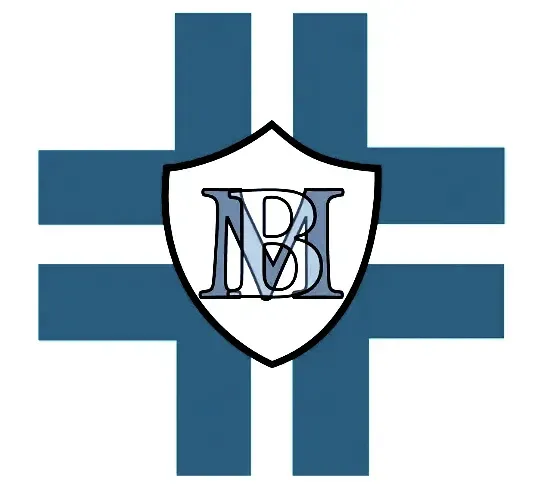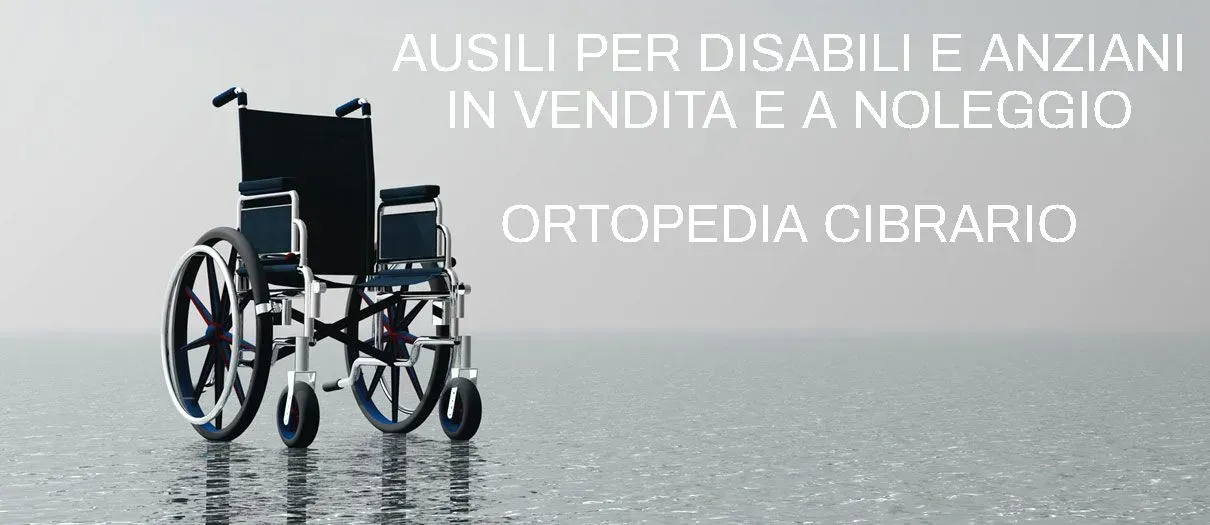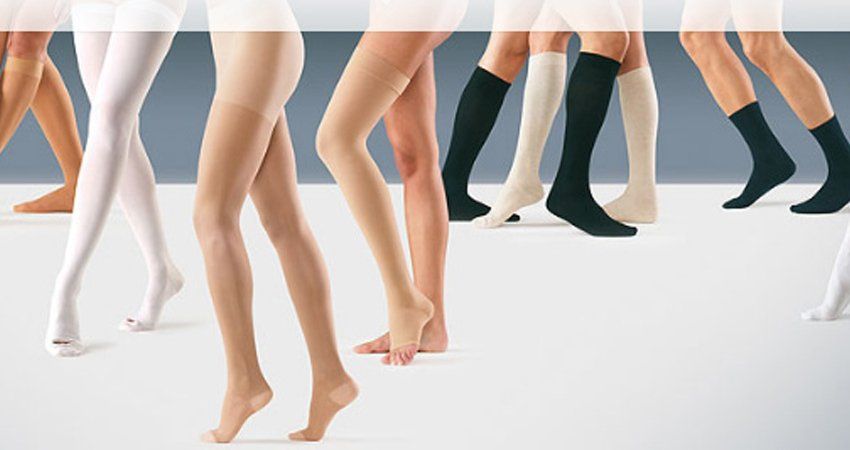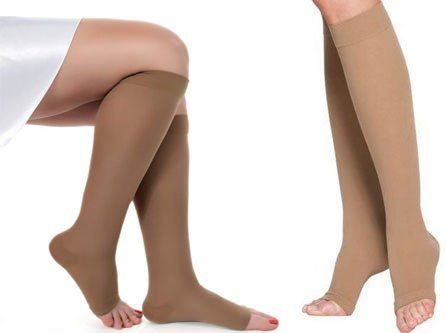ELASTOCOMPRESSIONE
Venous pathologies
• 10% of the population in developed countries suffer from chronic venous insufficiency.
Chronic venous insufficiency could affect 50% of adults, of which 12% have a disability.
• Varicose veins correspond to a permanent dilation of the superficial veins, with alteration of the wall.
The prevalence of varicose veins between the ages of 30 and 70 is 40%.
60% of women over 60 suffer from it.
Action of elastic stockings
The physical principles on which it is based are different depending on the indications and consequently on the basis
to the type of compression applied:
Restraint
Containment of muscle masses by opposing external counterpressure
to reduced elasticity during contraction and thus increasing the physiological support action of the muscles against
insufficient deep venous trunks (chronic venous insufficiency, postphlebitic syndrome)
and strengthening the so-called “muscle pump”.
The effect is therefore expressed mainly during physical exercise and walking.
Compression
Applied with highly elastic aids whose effect is exerted mainly on the most superficial planes
and on the external venous trunks, with a supporting action (mainly prevention) or collapsing of the superficial veins
to avoid refluxes inside them.
Characteristics of elastic stockings
Elastic stockings are in all respects a medical device and must meet specific defined structural characteristics
in specific international regulations, which they must comply with in terms of manufacturing criteria, quality of materials and identification
the degree and type of compression, conformation, guarantee, etc.
It is therefore evident that distribution and marketing, as well as
the prescription must take place within specialized circuits that have nothing to do with commonly used stockings
or with other products often advertised and presented with therapeutic characteristics, causing uncertainty and confusion in the end user.
Types of elastic stocking
Support line
Often defined as "preventive", they are mostly nylon stockings characterized by high elasticity and limited compressive action
and favorable aesthetics, with a wide range of models and colours, which differentiates them slightly from normal ones
socks and makes them particularly popular with patients.
Their degree of compression is generally indicated in denier (denier: 1 den = weight in grams of 9 km of yarn used)
or in mm/hg (14 – 18) at the ankle.
Compressions below 70 den or 14 mm/hg are not considered in phlebology.
Their use is indicated in the so-called "prevaricose states" (familiarity, venous hypotony), during sclerosing treatment, during pregnancy, for particular work activities, for maintaining results after surgery and for prevention.
of “new varicose veins”.
Furthermore, a favorable effect on edematofibrosclerotic panniculopathy (cellulite) is increasingly reported.
Therapeutic socks
They are socks characterized by higher levels of compression, less elasticity and less attractive aesthetics, however
the progressive efforts of the manufacturing companies have over time made more attractive models available (microfibre)
and in various colours.
The degree of compression, which decreases from the ankle to the thigh (graduated compression), is measured in mm/hg
and assigned to specific “compression classes”: 1K – 2 K – 3K – 4K (I – II – III –IV).
Identification of the model, compression class and size are very critical and require attention
and meticulousness on the part of the Specialist, as well as the evaluation of any contraindications (immobility, arterial disease, etc.).
The indications for their use are represented by Chronic Venous Insufficiency (persistent obstacle to venous return), Deep Vein Thrombosis, Postphlebitic Syndrome, prevention in pregnant women with high degree predisposition, stabilization
healing of venous ulcers, varicose veins in the presence of contraindications to surgery, lymphedema, etc.
“Anti-thrombus” stockings
These are particular measures applied for the prevention of Deep Vein Thrombosis (DVT) and its further very fearful evolution represented by Pulmonary Embolism (PE).
They are mostly indicated in subjects at risk (obesity, thrombophilia, elderly, heart patients, cancer, etc.) when they are
more in situations where this eventuality is fearful (surgical interventions, immobility, childbirth, etc.), in association or not
with pharmacological measures (Low Molecular Weight Heparins).
Postoperative stockings
Their use occurs after phlebological interventions (stripping, phlebectomies, etc.) for adequate compression in order to guarantee
the necessary hemostasis (control of bleeding) and the prevention of complications (training
of hematomas, phlebitis, DVT), replacing the application of elastic bands, used in the past, which were particularly uncomfortable for patients, hindered correct walking, as well as representing the origin of not rare complications linked to incorrect positioning or to inadvertent mobilization.
These are mostly specific monotights that are applied on the operating table at the end of the procedure.
Elastic stocking models
AD – Knee high: finds few applications, not allowing a complete application of the pressure gradient
ankle-thigh.
It is more often prescribed as a "fallback" in intolerant subjects or those experiencing objective difficulties (obesity, physical limitations)
to wear other models.
On the contrary, it is useful and comfortable for the "support line" in male patients, also providing models
in stretch cotton.
AG – mid thigh: poor indications due to the difficulty of keeping them in place and inadequate conformation
to the morphology of the limb.
However, the support line includes "hold-ups" (even particularly aesthetic ones) that can be used advantageously on patients
with limbs of harmonious proportions.
AT – tights: represents the model of choice in all cases in the standard model or with specific “conformal” sizes
and “maternity”
AT – monocollant: has specific indications in all the types described.
It is therefore clear that the identification and correct prescription of an elastic stocking are inevitably linked
to the competence and experience of the Specialist and cannot be left to the advice of a teller
or worse to improvised "do it yourself", also taking into consideration possible harmful effects deriving from incorrect use of devices
not adequate for the clinical case.
Venous elasticity? When it's missing it's a problem!
To function properly, veins must be elastic and valves efficient.
Varicose veins (or varicose veins) are veins of the superficial venous circulation which have lost the elasticity of the wall and which are more dilated than normal, and whose valves no longer function correctly.
In these veins the blood flows with difficulty and stagnates: over time therefore the veins
they dilate even more, taking on a tortuous appearance visible even to the naked eye, sometimes accompanied by pain.
Active life, correct eating habits and the use of elastic stockings are the preventive actions recommended by doctors and specialists.
Scientific studies have established with certainty that wearing medical stockings
with decreasing elastic compression it helps in the prevention and effectively combats venous disease.
Thrombosis while traveling: how to avoid it?
Indications for those traveling by plane but not only:
Long intercontinental flights, and long bus or train journeys can cause health problems for our lower limbs
for remaining in uncomfortable positions for several hours.
In addition to normal aches and pains, real pathologies can also occur, the most serious of which is certainly l
to venous thrombosis.
Regarding air travel, according to a study by the American College of Chest Physicians (ACCP), the subjects are most at risk
they are elderly, obese, pregnant women, people who have recently undergone surgery and above all smokers
if they choose to sit in the window seat on long-haul flights.
“Remaining immobile for a long time can increase the risk of a clot forming,” she says
Dr. Mark Crowther of McMaster University, Ontario.
Obviously the same considerations apply to those who travel long distances by car, coach and those who drive vehicles
making few stops and to a lesser extent for those traveling by train for more than 5 consecutive hours.
Remember that if a clot were to break, it could also lead to pulmonary embolism.
It is therefore important to follow some simple instructions.
First of all, try not to stay still for too long and if possible make short movements.
A simple walk along the aisle of the airplane or train greatly reduces the risk.
It is a good rule not to keep your limbs crossed for more than 10 consecutive minutes.
Stockings with decreasing elastic compression certainly help those subject to venous thrombosis significantly
and comfortable clothing.
How varicose veins are formed
In the lower limbs, the blood from the veins is drained through two venous systems, the superficial and the deep.
The two systems are in communication with each other through the perforating veins, equipped with valves that allow
the passage of blood only from the superficial circulation to the deep one, and not vice versa.
Varicose veins are the expression of a pathological state characterized primarily by the dilation of the large superficial veins
and perforating veins.
The causes can be multiple: heredity, foot or posture defects, sex (varicose veins are more frequent in women), pregnancy, obesity and professional activities that require standing or sitting for many consecutive hours.
Graduated compression elastic stockings provide a valid aid in prevention and treatment
of varicose veins.
Graduated compression: effective and constant action.
The pleasant sensation of lightness and well-being is achieved with the dynamic action of graduated compression.
Blood circulation is gently stimulated to encourage the return of venous blood.
The compression is decreasing, from the ankle upwards.
The new generation of preventive stockings.
Graduated compression knee-highs and stockings suitable for any person, both for those who remain in a standing or sitting position for many hours, or for those who carry out sporting activities, allowing rapid functional recovery of circulation
blood, preventing the formation of varicose veins and heaviness or swelling in the legs.
ELASTOCOMPRESSIONE
COMPRESSION SOCKS
To be therapeutic stockings, they must have a medically correct compression decreasing along the limb.
Unlike normal socks, these must be purchased from specialized stores.
Medical compression stockings are medical-therapeutic aids that are prescribed by the doctor according to need
and must be purchased from specialized retailers only after exact measurement of the legs.
When the doctor prescribes medical compression stockings, the patient goes with the prescription to the healthcare retailer, where the measurements of his legs are taken.
The patient receives information and advice on aids, so that he can choose a product suitable for his case.
But the therapy does not end here, because it continues with the renewal of the treatment, which is equally important.
Patients with vein problems should consult their doctor every six months, who decides based on need
on the renewal of treatment.
However, there are contraindications, i.e. situations in which compression stockings should not be used, such as arterial diseases (arterial hypertension, "smoker's leg").
Only the doctor can decide whether or not a medical compression stocking should be used.
COMPRESSIVE ELASTIC PANTS - MEDICAL DEVICE
The elastic stocking is a medical device and therefore it is essential that the model and possibly also the size are indicated
by the specialist doctor.
Therapeutic elastic stockings are classified by the degree of compression: mm HG
The therapeutic stockings for graduated support are produced thanks to computerized looms with excellent quality yarns and with antifungal and antibacterial treatments.
The elastic stocking is a medical device and therefore it is essential that the model and possibly also the size are indicated
by the specialist doctor.
Elastocompressione
It can be performed using fixed or mobile bandages or elastic stockings.
- Bandaging is the oldest treatment technique.
It constitutes an indispensable support for patients undergoing surgery and sometimes for those treated with sclerosing therapy.
The application of a medicated bandage may represent the only remedy for the treatment of varicose ulcers in patients
who do not want or cannot undergo surgical treatment.
- Elastic stockings represent a very important and indispensable tool for the prevention and treatment of diseases
of veins and their complications.
Their use is fundamental in the post-operative period, it is an essential support for sclerosing therapy to maintain the benefits of any bandage and avoid discomfort.



















